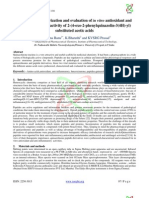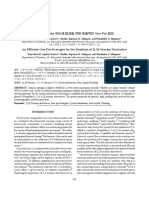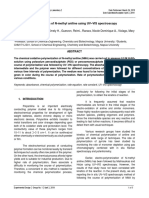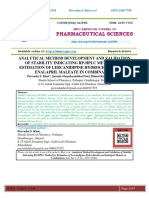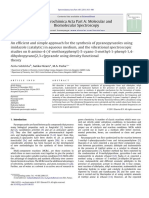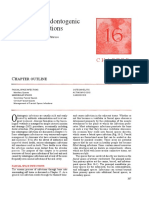0601201601
0601201601
Uploaded by
dhruv chabriaCopyright:
Available Formats
0601201601
0601201601
Uploaded by
dhruv chabriaCopyright
Available Formats
Share this document
Did you find this document useful?
Is this content inappropriate?
Copyright:
Available Formats
0601201601
0601201601
Uploaded by
dhruv chabriaCopyright:
Available Formats
See discussions, stats, and author profiles for this publication at: https://www.researchgate.
net/publication/301730665
Chemical Derivatization UV Spectrophotometric Method for Detection of P-
Aminophenol and Energy of Activation Approach to Set Degradation Protocol
for Forced Degradation Studies
Article · January 2016
CITATIONS READS
2 4,203
5 authors, including:
Gitanjali Deokar Sanjay Kshirsagar
MET's Institute of Pharmacy, Bhujbal Knowledge City, Mumbai Educational Trust, … Mumbai Educational Trust
28 PUBLICATIONS 106 CITATIONS 127 PUBLICATIONS 924 CITATIONS
SEE PROFILE SEE PROFILE
All content following this page was uploaded by Gitanjali Deokar on 30 April 2016.
The user has requested enhancement of the downloaded file.
International Journal of Pharma Research & Review, Feb 2016;5(2):1-12 ISSN: 2278-6074
Research Article
Chemical Derivatization UV Spectrophotometric Method for Detection of P-
Aminophenol and Energy of Activation Approach to Set Degradation Protocol for
Forced Degradation Studies
Gitanjali S. Deokar, Indrayani S. Pagare, Ansari Md Naseem*, Sanjay Kshirsagar, Lavesh Shindhe
Department of Quality Assurance, MET's Institute of Pharmacy, Bhujbal Knowledge City, Adgaon Nashik,
Maharashtra, India.
ABSTRACT
A spectrophotometric method has been developed for the determination of paracetamol in a dosage form
and in Pharmaceutical preparation. The method is based on the reaction of p-aminophenol group of the
drug with ninhydrin in N, N. dimethylformamide (DMF) medium producing a coloured complex which
absorbs maximally at 547 nm. Beers law is obeyed in the concentration range 1-3μg/ml and with set
parameter the method is validated, LOD and LOQ were found to be 0.254, 0.770 and 0.2849, 0.863 by
standard deviation of blank and calibration curve method respectively. As it is having least sum square
error that is 1.448667 × 10 -5. Method is found to be specific for the para amino phenol, data supported
by ANOVA test with at P ≤ 0.05. For accuracy and precision we are 99℅ sure that the results lie between
100.32-99.26℅ and 100.19 to 100.07℅ respectively. From the principle of energy of activation the force
degradation of Paracetamol in tablet dosage form is carried out at 100ᵒc for 3 days, degradation of
Paracetamol was found to be 0.7℅ Hence the method is developed and validated for the detection of p-
amino phenol, a degradation product of paracetamol and by using concept of energy of activation p-amino
phenol from paracetamol drug product is estimated the results were validated statistically.
Keywords: Ninhydrin, paracetamol, pharmaceutical preparation, spectrophotometry
Received 6 Jan 2016 Received in revised form 28 Jan 2016 Accepted 30 Jan 2016
*Address for correspondence:
Ansari Md Naseem,
Department of Quality Assurance, MET's Institute of Pharmacy, Bhujbal Knowledge City, Adgaon Nashik,
Maharashtra, India.
E-mail: naseempharma1990@gmail.com
_________________________________________________________________________________________________________________________
1. INTRODUCTION
Paracetamol, acetaminophen or N-acetyl-p- level of 0.005 % (w/w) i.e.50 ppm in the
aminophenol is commonly used analgesic drug substance by European
and antipyretic drug, present in different pharmacopoeia .The significant limit of p-
pharmaceutical formulations such as aminophenol may vary in different products
tablets, soluble powder syrups and depends on dosage forms and formulations.
suppositories. It is administered to both The monograph of paracetamol tablet in BP
children and adults. [1, 2] The primary allows 0.1 %. For drug product containing
degradation product of paracetamol is 4- paracetamol often less tight limits are
aminophnol or 1-hydroxy-4- applied such as 1000 ppm or 0.1 % (w/w).
aminobenzone.It is formed during the Internally the lower drug substances
synthesis of paracetamol or during the specification limit is applied to product 50
storage condition of pharmaceutical ppm is equivalent to 25g of p-aminophenol
formulation such as heat, pH, temp etc. [3, per 500 mg tablet. [5] The present work
4] Paracetamol degrades slowly forming a describes simple, sensitive, accurate,
mixture of contaminants such as 4- precise, economical visible spectrophoto-
aminophenol and acetic acid. [3, 4] meteric method using ninhydrin reagent for
It is reported that p-aminophenol have estimation of p aminophenol in paracetamol
significant nephrotoxic and tetratogenic dosage form. Ninhydrin is a 2, 2,
effects, therefore its amount should be dihydroyindane 1,3-dione [6] which react
strictly controlled. [5] It is limited to a low with the primary amino group of p-
Ansari Md Naseem et.al, IJPRR 2016; 5(2) 1
International Journal of Pharma Research & Review, Feb 2016;5(2):1-12 ISSN: 2278-6074
aminophenol to yield purple color by the formation of coordination (in which
derivative called Ruhemans purple and both electrons are donated by the ligand)
hydroquinone. [7] and covalent bonds ligands with two or
1.1. Chemical Derivatization more donating groups may share more than
Derivatization is a technique which one pair of electrons with a single metal
transforms a chemical compound into a atom by coordinating to two or more
product of similar chemical structure. It positions. [8]
changes chemical and physical properties. 1.2. Ninhydrin
Chemical derivatives may be used to The chemistry of ninhydrin has been
facilitate analysis. Chemical Derivatization studied extensively. Ninhydrin is a triketo
modifies or converts substances with a low, compound; much of the work has been
UV absorption into highly sensitive directed towards the reaction of amines
products. [8, 19] with ninhydrin. This pigment serves as the
1.1.1. Types of Chemical Derivatization basis of detection and quantitative
Methods estimation of amino acids, the reaction is
1. Diazotisation and coupling of primary usually carried out by heating for short time
aromatic amines in a mixture of water and organic solvents.
The amine is diazotised with aqueous [7, 9, 10]
solution of Nitrous acid, the colorless 1.3. Energy of Activation
diazonium salt is very reactive and when Activation energy is a term introduced in
treated with suitable coupling reagent like 1889 by the Swedish scientist Syante
aromatic amine or phenol undergoes an Arrhenius that is defined as the energy that
electrophilic substitution reaction to must be overcome in order for a chemical
produce an azo derivative. The azo reaction to occur. Activation energy may
derivatives are colored and have absorption also be defined as the minimum energy
maximum in UV visible region at λ max550 required starting a chemical reaction. The
nm. [8] activation energy of a reaction is usually
2. Condensation Reaction denoted by Ea and given in units of
Many Colorimetric procedures are based on kilojoules per mole. [11]
rapid reaction that occurs under suitable
condition between amines and carbonyl [ ]
compounds. The reaction involves the
nucleophilic attack by the amine on the
carbonyl carbon with the elimination of Where
water. [8] Ea is the activation energy of the reaction in
3. Reduction of tetrazolium salts J/mol
Tetrazolium salts are reduced to their R is the ideal gas constant = 1.98 cal / deg·
colored form azan derivatives in the mol
presence of a Steroid with α-ketol (21- T1 and T2 are absolute temperatures
hydroxy-20-keto) side chain group. [8] Convert T1 and T2 in Kelvin
4. The acid-dye method K1 and K2 are the reaction rate constants at
The addition of an amine in its ionized form T1 and T2
to an ionized acidic dye, i.e. methyl orange 2. MATERIALS AND METHODS
or bromocresol purple, yields a salt (ion- 2.1. Apparatus
pair). [8] A UV-visible spectrophotometer (Shimadzu,
5. Oxidation methods model 1800) with 1 cm quartz cells was
Oxidation of side chain of weakly absorbing used for the absorbance measurements.
compounds containing a simple phenyl 2.2. Materials
group produces a carbonyl derivative that Para amino phenol in the form of powder
has a much greater absorptivity than the was provided by Thomas Baker, Mumbai,
parent compound. [8] and DMF in the form of liquid was provided
6. Metal-ligand complexation by LOBA Chemie, India, which was used in
Many organic reagents that are called
ligands forms complexes with metal atoms
Ansari Md Naseem et.al, IJPRR 2016; 5(2) 2
International Journal of Pharma Research & Review, Feb 2016;5(2):1-12 ISSN: 2278-6074
analytical method development and 2.5.3. Method based on Calibration Curve
validation. Prepare 0.001ppm to 2.0 ppm of para
2.3. Determination of wavelength of aminophenol solution from stock solution
maximum absorption respectively. Analysis were carried out
A standard stock solution of Para Amino using 2% w/v ninhydrin reagent; 3 ml were
Phenol (100 μg/ml) was prepared using added and mixed, heated on water bath at
DMF as diluents and 1 to 5 ml of standard 700 C ± 20 C for 30 minutes, cooled at room
solution was then diluted to obtain 10 ml temperature and volume in each were
with DMF to obtain 10 to 50 μg/ml Para adjusted to 10ml with DMF, The absorbance
Amino Phenol. An UV spectroscopic of resulting solution was measured 10 times
scanning (200– 600nm) was carried out to at 547nm.
determine the λ max. In this study, LOD and LOQ were based on
2.4. Method the standard deviation of the response and
2.4.1. Preparation of stock solution the slope of the corresponding curve using
10mg of the pure drug was weighed and the following equations
transferred to a 100ml volumetric flask;
50ml DMF was added to the above flask and
dissolved, the volume was made up with the Where,
DMF. = Standard Deviation
2.4.2. Preparation of ninhydrin reagent S = Slope
2gm of the ninhydrin was weighed and Cut off range was found to be 0.03
transferred to a 100ml volumetric flask,
50ml DMF was added to the above flask and Table 1: Determination LOD and LOQ
dissolved, the volume make up 100ml with based on calibration curve calculations
the DMF. Sr. No Conc. µg/ml Abs at 547nm
2.5. Method validation 1 0.03 0.00209
Analytical method development and 2 0.04 0.0025
validation for detection of p-aminophenol in 3 0.05 0.0035
the paracetamol bulk dosage form by ICH 4 0.06 0.0037
guideline. 5 0.07 0.0045
2.5.1. Limit of Detection (LOD) and Limit 6 0.08 0.00507
of Quantitation (LOQ) 7 0.09 0.0056
2.5.1.1. LOD 8 0.1 0.0061
It is the lowest amount of analyte in a 9 0.2 0.0077
sample that can be detected but not 10 0.3 0.01012
necessarily quantitated under the stated 11 0.4 0.01774
experimental conditions. [12-15] 12 0.5 0.01906
2.5.1.2. LOQ 13 0.6 0.02381
Lowest concentration or amount of analyte 14 0.7 0.02792
that can be detected quantitatively with an 15 0.8 0.03302
acceptable level of repeatability, precision 16 0.9 0.03697
and trueness. [12-15] 17 1.0 0.04062
2.5.2 Method based on Standard Deviation 18 1.1 0.04554
of blank 19 1.2 0.0494
Analysis were carried out using 2% w/v 20 1.3 0.0532
ninhydrin reagent; 3 ml were added and 21 1.4 0.05762
mixed, heated on water bath at 700 C ± 20 C 22 1.5 0.062
for 30 minutes, cooled at room temperature 23 1.6 0.06821
and volume in each were adjusted to 10 ml 24 1.7 0.07252
with DMF, The absorbance of resulting 25 1.8 0.07751
solution was measured 10 times at 547nm. 26 1.9 0.0797
27 2.0 0.0868
Ansari Md Naseem et.al, IJPRR 2016; 5(2) 3
International Journal of Pharma Research & Review, Feb 2016;5(2):1-12 ISSN: 2278-6074
Figure 1: Calibration Curve for p-amino phenol for LOD & LOQ (0.03 to 2µg/ml)
Standard stock solution para amino phenol
(1.0 ml) were transferred to a 10ml of
LOD = 3.3 x 0.00388597 ambered colored volumetric flask, 2% w/v
0.045 ninhydrin reagent; 3.0 ml were added and
mixed. The flask were immediately
LOD = 0.284971 µg/ml immersed in a water bath 700 C ± 20 C for 30
minutes, cool to room temperature and the
volume were adjusted to 10 ml with DMF.
The absorbance of resulting solution was
LOQ = 10 x 0.00388597 measured at 547nm against blank.
0.045 The absorbance of the samples in the range
LOQ = 0.8635 µg/ml of 2–12μ g/ml was linear with a correlation
coefficient (R2) 0.999.
2.5.4. Linearity and Range
2.5.4.1 Linearity Table 2: Data for calibration curve
Linearity indicates the ability to produce
results that are directly proportional to the Sr. Concentration Absorbance
concentration of the analyte in samples. [12, no (μg /ml) at 447nm
13, 15, 16] 1 2 0.0812
2.5.4.2 Range 2 4 0.1801
Range is an expression of the lowest and 3 6 0.2682
highest levels of analyte that have been 4 8 0.3593
demonstrated to be determinable for the 5 10 0.4449
product. [12, 13, 15, 16] 6 12 0.5392
Figure 2: Calibration Curve for p-amino phenol (2 to 12µg/ml)
Ansari Md Naseem et.al, IJPRR 2016; 5(2) 4
International Journal of Pharma Research & Review, Feb 2016;5(2):1-12 ISSN: 2278-6074
2.5.5. Specificity 2.5.6. Accuracy
Specificity (selectivity) is the ability to Accuracy is the degree of agreement of test
measure unequivocally the desired analyte results with the true value, or the closeness
in the presence of components such as of the results obtained by the procedure to
excipients and impurities. [12, 13, 17, 18] the true value. [12, 13, 15, 17, 18]
Standard solution of para amino phenol (0.4 Prepare 20 µg/ml of para aminophenol
ml) from stock solution A. Add 3.0 ml of 2% solution in three sets from stock solution.
w/v ninhydrin reagent and mixed, Spike standard para amino phenol in
immediately heated on water bath 700 C ± concentration of 50, 100,150% respectively.
20 C for 30 minutes, cooled at room Analysis were carried out using 2% w/v
temperature. Now spiking Paracetamol in 3 ninhydrin reagent; 3.0 ml were added and
different levels 50,100,150% respectively mixed, immediately heated on water bath
from stock solution B, make up the volume 700 C ± 20 C for 30 minutes, cooled at room
to 10ml with DMF, The absorbance of temperature and volume adjusted to 10 ml
resulting solution was measured at 547nm with DMF, The absorbance of resulting
against blank. solution was measured at 547nm against
Spiking Paracetamol in 3 different levels blank. Solution stability was also performed
50,100,150% respectively from stock simultaneously for 2 hours highlighted in
solution B to determine the amount of (Table 4).
℅recovery at 547nm.
Table 3: % Recovery studies for specificity
Sr. Conc. of API Add ℅ Spike stock Abs. at Drug found ℅ Recovery
No μg/ml level sol. μg/ml 547nm μg/ml
1 4 50 2 0.1812 4.14 103.5
2 4 100 4 0.1812 4.136 103.4
3 4 150 6 0.1816 4.146 103.7
Table 4: Accuracy Study with Solution Stability
After 1 Hour
Sr. No conc. Of ml of Level of Spike Total conc. Abs. at Drug ℅
API stock add. ℅ API in μg/ml 547 nm found recovery
sol. ml μg/ml
1 20 2 50 1 30 1.334 29.76 99.31
2 20 2 100 2 40 1.797 40.03 100.1
3 20 2 150 3 50 2.242 49.93 99.91
After 2 Hours
1 20 2 50 1 30 1.336 29.8 99.42
2 20 2 100 2 40 1.799 40.66 100.2
3 20 2 150 3 50 2.243 49.86 99.97
2.5.7. Precision mixed, immediately heated on water bath
Precision is the degree of agreement among 700 C ± 20 C for 30 minute, cooled at room
individual results. The complete procedure temperature and volume adjusted to 10 ml
should be applied repeatedly to separate, with DMF, The absorbance of resulting
identical samples drawn from the same solution was measured at 547nm against
homogeneous batch of material. [12, 13, 15, blank. The same complex solution were
17, 18] taken and the absorbance were measured at
Prepare 20µg/ml of para aminophenol 547nm at 4 different time intervals (i.e. at
solution in three sets from stock solution. 30 minutes, 60 minutes, 90 minutes, 120
Spike standard para aminophenol in minutes).
concentration of 50,100,150% respectively. The interday precision and intraday
Analysis were carried out using 2% w/v precision are applied to determine the
ninhydrin reagent; 3.0 ml were added and sample stability. The interday precision and
Ansari Md Naseem et.al, IJPRR 2016; 5(2) 5
International Journal of Pharma Research & Review, Feb 2016;5(2):1-12 ISSN: 2278-6074
intraday precision was found RSD is less
than 2℅.
3. Calculation
3.1. Energy of Activation Ea [11, 20]
3.1.1. Water bath
Table 5: Calibration Curve of Paracetamol in 0.01M H2SO4
Sr. No Concentration µg/ml ml of Stock Solution ml of 0.01M H2SO4 Absorbance
1 2 0.2 9.8 0.2349
2 3 0.3 9.7 0.2383
3 4 0.4 9.6 0.3140
4 5 0.5 9.5 0.4028
5 6 0.6 9.4 0.4761
6 7 0.7 9.3 0.5410
7 8 0.8 9.2 0.6035
8 9 0.9 9.1 0.6835
Figure 3: Calibration curve of Paracetamol in 0.01M H2SO4 ( max-372 nm)
Table 6: Determination of specific reaction rate constant (K1, at room temperature)
Sr. Time Abs (a-x) Conc. (a-x) Log (a-x) K1 = 2.303 log a
No Minutes µg/ml t (a-x)
1 Initial 0.3208 4.0112 0.60327 ---
2 30 0.3450 4.3521 0.63869 0.27188 x 10-4
3 60 0.3135 3.9084 0.59199 4.3292 x 10-4
4 90 0.3129 3.90 0.59106 3.12331 x 10-4
5 120 0.3123 3.8915 0.59011 2.5254 x 10-4
6 150 0.2905 3.5845 0.55442 7.49847 x 10-4
7 180 0.2866 3.5295 0.54771 7.106124 x 10-4
8 210 0.2627 3.1929 0.50418 0.108602 x 10-4
9 240 0.2614 3.1746 0.50168 9.748373 x 10-4
Mean = 9.041325 x 10-4/min
Ansari Md Naseem et.al, IJPRR 2016; 5(2) 6
International Journal of Pharma Research & Review, Feb 2016;5(2):1-12 ISSN: 2278-6074
Table 7: Determination of specific reaction rate constant (K2, at 60ºC)
Sr. Time Abs (a-x) Conc. (a-x) Log (a-x) K2 = 2.303 log a
No Minutes µg/ml t (a-x)
1 Initial 0.3553 4.4971 0.65293 ---
2 30 0.3265 4.0915 0.61188 3.1509 x 10-3
3 60 0.2932 3.6225 0.5590 3.60503 x 10-3
4 90 0.1584 1.72394 0.23652 0.010651
5 120 0.1527 1.64366 0.21579 8.3883 x 10-3
6 150 0.1580 1.71830 0.23509 6.41384 x 10-3
7 180 0.1350 1.39436 0.14437 6.5044 x 10-3
8 210 0.0611 0.35352 - 0.45158 0.012105
9 240 0.0507 0.20704 - 0.68394 0.012828
Mean = 7.561975 x 10-3/min
Table 8: Determination of specific reaction rate constant (K3, at 800C)
Sr. Time Abs (a-x) Conc. (a-x) Log (a-x) K3 = 2.303 log a
No minutes µg/ml t (a-x)
1 Initial 0.3400 4.2816 0.65293 ---
2 30 0.1924 2.2080 0.61188 0.0220769
3 60 0.1326 1.3605 0.5590 0.01910947
4 90 0.0099 - 0.3676 0.23652 5.03874 x 10-3
5 120 0.0071 - 0.4070 0.21579 4.62862 x 10-3
6 150 0.0067 - 0.4126 0.23509 3.79344 x 10-3
7 180 0.0026 - 0.47042 0.14437 3.8893 x 10-3
8 210 - 0.0418 - 1.09577 - 0.45158 6.49056 x 10-3
9 240 - 0.0013 - 0.5253 - 0.68394 3.3778281 x 10-3
Mean = 8.55060725x 10-3/min
3.1.1.1. Calculation for Energy of Activation (Ea): For room temp and 600C
[ ]
Where K1 and K2= Mean of Room temperature and 600C
Convert T1 and T2 in Kelvin, hence add 273
Ea= 2.303 [(20 + 273) (60 + 273) 1.98] X Log 0.007561975
[(20 + 273) – (60 + 273)] 0.0009041325
Ea= 444908.7859 X (-2.121364763) – (-3.043767919)
40
Ea= 11122.71965 X 0.922403156 = 10.25963171 Kcal/mole
3.1.1.2. Energy of Activation (Ea): For room temp and 800C
[ ]
Where K1 and K3 = Mean of Room temperature and 800C
Convert T1 and T3 in Kelvin, hence add 273
Ea= 2.303 [(20 + 273) (80 + 273) 1.98] X Log 0.00855060725
[(20 + 273) – (80 + 273)] 0.0009041325
Ea= 471630.0343 X (-2.068003054) – (-3.043767919)
60
Ea= 7860.500571 X 0.975764865 = 7.670000278 Kcal/mole.
Ansari Md Naseem et.al, IJPRR 2016; 5(2) 7
International Journal of Pharma Research & Review, Feb 2016;5(2):1-12 ISSN: 2278-6074
3.1.2. Hot air oven
Table 9: Calibration Curve of Paracetamol in 0.01M NaOH
Sr. Concentration ml of Stock ml of 0.01M Absorbance
No µg/ml Solution H2SO4
1 2 0.2 9.8 0.3194
2 4 0.3 9.7 0.4103
3 6 0.4 9.6 0.4984
4 8 0.5 9.5 0.5895
5 10 0.6 9.4 0.6738
6 12 0.7 9.3 0.7514
Figure 4: Calibration curve of Paracetamol in 0.1M NaOH ( max-257 nm)
Table 10: Specific reaction rate constant Paracetamol Degradation in Bulk in hot air oven
(K1,at 1200 C)
Sr. Time Abs (a-x) Conc. (a-x) Log (a-x) K1 = 2.303 log a
No Minutes µg/ml t (a-x)
1 Initial 0.5995 8.4534 0.9270 ---
2 60 0.5979 8.4162 0.9251 7.25382 x 10-5
3 120 0.5648 7.6460 0.8834 8.36684 x 10-4
4 180 0.5413 7.10 0.8512 9.69482 x 10-4
5 240 0.5281 6.7930 0.8321 9.106414 x 10-4
6 300 0.5211 6.630 0.8215 8.0989185 x 10-4
Mean=7.06790614x 10-4/min
Table 11: Specific reaction rate constant Paracetamol Degradation in Bulk in hot air oven
(K2, at1400 C)
Sr. Time Abs (a-x) Conc. (a-x) Log (a-x) K2 = 2.303 log a
No Minutes µg/ml t (a-x)
1 Initial 0.5995 8.4534 0.9270 ---
2 60 0.5990 8.4418 0.9264 2.3028 x 10-5
3 120 0.5460 7.2093 0.8579 1.326029 x 10-3
4 180 0.5152 6.4930 0.8124 1.466192 x 10-3
5 240 0.4739 5.5326 0.7429 1.766592 x 10-3
6 300 0.4337 4.5977 0.6625 2.0304872 x 10-3
Mean = 1.3183206 x 10-3/min
Ansari Md Naseem et.al, IJPRR 2016; 5(2) 8
International Journal of Pharma Research & Review, Feb 2016;5(2):1-12 ISSN: 2278-6074
Table 12: Specific reaction rate constant Paracetamol Degradation in Bulk in hot air oven
(K3, at 1600 C)
Sr. Time Abs (a-x) Conc. (a-x) Log (a-x) K3 = 2.303 log a
No Minutes µg/ml t (a-x)
1 Initial 0.5995 8.4534 0.9270 ---
2 60 0.5619 7.57907 0.8796 1.819212 x 10-3
3 120 0.5266 6.7581 0.82983 1.8646923 x 10-3
4 180 0.4740 5.5349 0.7431 2.35289016 x 10-3
5 240 0.4214 4.31163 0.63464 2.805436859 x 10-3
6 300 0.3688 3.0884 0.48973 3.356790609 x 10-3
Mean =2.439804386 x 10-3/min
3.1.2.1. Calculation for Energy of Activation (Ea): For 1200 C and 1400 C
[ ]
Where K1 and K2 = Mean of 1200 C and 1400 C
Convert T1 and T2 in Kelvin, hence add 273
Ea= 2.303 [(120 + 273) (140 + 273) 1.98] X Log 0.0013183206
[(120 + 273) – (140 + 273)] 0.000706790614
Ea= 740119.3015 X (-2.879978962) – (-3.150709226)
20
Ea= 37005.96507 X 0.270730266 = 10.01863477 Kcal/mole
3.1.2.2. Calculation for Energy of Activation (Ea): For 1400 C and 1600C
[ ]
Where K2 and K3 = Mean of 1200 C and 1400 C
Convert T2 and T3 in Kelvin, hence add 273
Ea= 2.303 [(140 + 273) (160 + 273) 1.98] X Log 0.0024398043
[(160 + 273) – (140 + 273)] 0.0013183206
Ea= 815449.5103 X (-2.612644992) – (-2.879978962)
20
Ea= 40772.47551 X 0.26733397 = 10.89986774 Kcal/mole.
3.1.2.3. Calculation for Energy of Activation (Ea): For 1600 C and 1200 C
[ ]
Where K1 and K3 = Mean of 1200 C and 1600 C
Convert T1 and T3 in Kelvin, hence add 273
Ea= 2.303 [(120 + 273) (160 + 273) 1.98] X Log 0.0024398043
[(160 + 273) – (120 + 273)] 0.0013183206
Ea= 775960.4299 X (-2.612644992) – (-3.150709226)
40
Ea= 19399.01075 X 0.538064234 = 10.43791386 Kcal/mole.
Ansari Md Naseem et.al, IJPRR 2016; 5(2) 9
International Journal of Pharma Research & Review, Feb 2016;5(2):1-12 ISSN: 2278-6074
Energy of Activation for paracetamol was considering the energy of activation to be
found to be 10 Kcal/mol 10 Kcal/mole. The degraded product was
Assuming Energy of 12 Kcal/mol affords estimated by the prepared method. [20]
nearly doubling of reaction rate for every 3.2. Paracetamol Degradation
10ºC rise in temperature. Take 9 tablets of Calpol 500 mg, covered
With this relationship one can calculate the with aluminum foil was kept in hot oven at
amount of time a sample should be stored at 100 0C for 3 days. [5, 10]
a specified temperature to achieve the After heating each tablet was triturated,
energy equivalent of exposure at Weight equivalent to 5 mg of paracetamol,
accelerated stability conditions (40 ºC for 6 5.7 mg of tablet powder was for analysis
months) so to keep at 80 ºC (every 10 ºC using 2% w/v ninhydrin reagent; 3.0 ml
rise 24) were added and mixed, immediately heated
180 days (6 months) / 24 = 11.25 = 12days. on water bath 700 C ± 20 C for 30 minutes,
A sample of bulk drug substance stored at cooled at room temperature and volume
80 ºC would be stored for 12 days is adjusted to 10 ml with DMF, The
kinetically equivalent to 40 ºC for 6 months. absorbance of resulting solution were
Using the same concept paracetamol drug measured at 547nm against blank.
product was kept at 100 ºC for 3 days
Table 13: ̅ Found (For tablet degradation) at 1000C for 3 days
Tab. Powder mg Abs 547 nm Mean ̅
5.7 1.7
5.7 1.8
5.7 1.7
5.7 1.6
5.7 1.5 1.6412
5.7 1.4
5.7 1.5
5.7 1.4
5.7 1.6
Absorbance of degraded paracetamol i.e. P-amino phenol is 1.6412,
Concentration of p-amino phenol =
Y = 0.0454x – 0.0054
1.6412 = 0.0454 x – 0.0054
X= 36.2687 µg/ml
Weight equivalent to 5 mg of paracetamol, In present study by using chemical
5.7 mg of tablet powder was analyzed and Derivatization, UV method is developed for
P- amino phenol was found to be the determination of the Para -Amino
36.2687µg/ml, thus the degradation is 0.7% phenol, which is a degraded product of
from the tablet dosage form. paracetamol. For the preparation of stable
4. RESULTS AND DISCUSSION complex of para amino phenol solvents like
A spectrophotometric method was Water, Methanol, Acetone, Ethanol, DMF are
developed for quantitative determination of used, and DMF showing stable readings
degraded amino group in sample and among all other solvents. Accordingly
reduces unnecessary tedious sample concentration of Ninhydrin 3ml of 2% w/v,
preparation. heating time 30 minutes at 70 ºC decided
The ninhydrin has been known as a reagent for formation of stable complex.
for detection of amino acid and amines. It With set parameter the method is validated,
was suggested that the reaction of LOD and LOQ were found to be 0.254(Table
ninhydrin with amine, amino acid and imino 1, and Fig. 1), 0.770 and 0.2849 (Table 1,
acids all produced by the mechanism to give and Fig. 1), 0.863 by standard deviation of
the Ruhemans purple. blank and calibration curve method
Ansari Md Naseem et.al, IJPRR 2016; 5(2) 10
International Journal of Pharma Research & Review, Feb 2016;5(2):1-12 ISSN: 2278-6074
respectively. Among the entire range 1 to was considered, indicates that the results lie
30 µg/ml Linearity range was found to be 2 between 100.32-99.26% and 100.19 to
to 12 µg/ml (Table 2, and Fig. 2) as it is 100.07% respectively (Table 4). From the
having least sum square error i.e. 1.448667 principle of energy of activation the forced
x 10-5. Method is found to be specific for the degradation of paracetamol in tablet dosage
para amino phenol, data supported by form is carried out at 100ºC for 3 days,
ANNOVA test with at P ≤ 0.05. For accuracy degradation of paracetamol was found to be
and precision confidence interval of 99% 0.7% (Table 13).
Table 14: Result of various validation parameters
Parameters Values
Linearity and range (μ/ml) 2-12 μg/ml
Precision (% RSD) RSD< 2%
Accuracy(% Recovery) 99.86 %
ANOVA P ≤ 0.05
LOD (μg/ml) 0.284971
LOQ (μg/ml) 0.8635
Energy of Activation 10.43791386 Kcal/mole
Degradation of Paracetamol 0.7 %
5. CONCLUSION Institute of Pharmacy, Bhujbal Knowledge
In present study by using chemical City, Nashik for providing necessary
derivatization, UV method is developed for research facilities. Thanks are also extended
the determination of the Para -Amino to S.D FINE CHEM ltd for providing gift
phenol, which is a degraded product of sample of pure Paracetamol and P-
paracetamol for the preparation of stable aminophenol.
complex of Para amino phenol and DMF REFERENCES
showing stable readings among all other 1. Bloomfield M.S. (2008) Validation of a
solvents. Fluorimetric assay for 4-aminophenol in
The developed spectrophotometric method paracetamol formulation. Talanta75, pp. 258-
was simple, sensitive and specific for the 265.
2. Prescott, L.F. (2000) Am. J. Ther, 7, pp.143-
detection of amino group in bulk and
147.
pharmaceutical formulation. It could be 3. Patel, P.S. et al. (2000) Studies on synthesis
precisely LOD was found to and dyeing performance of disperse azo dyes
be0.284971μg/ml and LOQ was found to be Based on Schiff base of ninhydrin and 4-
0.8635 μg/ml. The calibration curve shows aminophenol. Journal of Chemical and
linear relationship between the absorbance Biochem.9, pp.135.
and concentration and the coefficient 4. Patel, S.K et al (2011) Spectrophotometric
correlation was higher than 0.99. Precision determination of Ceplalexin using ninhydrin
was found to be less that 2%. The % reagent in tablet dosage form. International
recovery was found to be 99% and sample Research Journal of Pharmacy, 2(9) pp.123-
126.
solution stable for 2 hrs and the
5. Bloomfield, M .S. (2002) a sensitive and rapid
degradation of Paracetamol was found to be assay for 4-aminophenol in paracetamol drug
0.7% At 100 ºC for 3 days. tablet formulation by flow injection analysis
Hence the method is developed and with spectrophotometric detection.
validated for the detection of p-amino Talanta,580, pp.1301-1310.
phenol, a degradation product of 6. Patel, P.S. et al. (2000) Studies on synthesis
paracetamol and by using concept of energy and dyeing performance of disperse azo dyes
of activation p-amino phenol from Based on Schiff base of ninhydrin and 4-
paracetamol drug product is estimated. aminophenol. Journal of Chemical and
ACKNOWLEDGEMENTS Biochem.9, pp.135.
7. Patel, S.K et al (2011) Spectrophotometric
The authors are grateful to Department of
determination of Ceplalexin using ninhydrin
Quality Assurance Techniques, MET
Ansari Md Naseem et.al, IJPRR 2016; 5(2) 11
International Journal of Pharma Research & Review, Feb 2016;5(2):1-12 ISSN: 2278-6074
reagent in tablet dosage form. International
Research Journal of Pharmacy, 2(9) pp.123-
126.
8. Beckett A.H, Stenlake J.B.( 2004), “Practical
Pharmaceutical Chemistry,” part2, CBS
Publishers and Distributors, Delhi ,4, pp. 300-
305.
9. Nafisur Rahman, Sayed najmul, Hejaz Azmi,
Spectrophotometric method for
determination of amlodipine besylate with
ninhydrin in drug formulation, ELSEVIER, ІІ
Farmaco 56, jan.2001, page no.731-735.
10. Nafisur Rahman, Mohammad Kashif,
Application of ninhydrin to
Spectrophotometric determination of
famotidine in drug formulation, ELSEVIER, ІІ
Farmaco 58, april.2001,page no.1045-1050.
11. H.N More, A.A. Hajare, Practical physical
pharmacy, career publication, second edition
august 2010, page no.189-192.
12. International Conference on Harmonization,
(1996) Guidance on Validation of Analytical
Procedures: Methodology, Federal
register, 61, pp.59-62.
13. International Conference of Harmonization
(ICH) of Technical Requirements for the
Registration of Pharmaceuticals for Human
Use, Validation of Analytical Procedures:
Methodology, Adopted in Geneva (1996).
14. G.C. Hokanson, A Life Cycle Approach to the
Validation of Analytical Methods during
Pharmaceutical Product Development, Part–
II: Changes and the Need for Additional
Validation, Pharm. Tech., 92 -100 (1994).
15. Nash, A. N, Pharmaceutical Process
Validation, An international edition, 3, 129,
pp.507-523.
16. International Conference on Harmonization
(1996) Validation of analytical procedures:
Methodology, Technical Requirements for
the Registration of Pharmaceuticals for
Human Use, ICH-Q2B, Geneva 1996.
17. F.W. Fifield and D.Kelley, 5th Edition, Black
Well Science Ltd. Principles and Practice of
Analytical Chemistry, (2000) pp. 270 –276.
18. Saraf, S. (2006) Various UV
spectrophotometric Simultaneous estimation
methods. Pharmainfo.net, pp. 1-3.
19. Bagade, S.B. et al. (2010) Spectrophotometric
Estimation of Torsemide in Tablet Dosage
Form Using Chemical Derivatization
Technique: Research Article International
Journal of Pharmaceutical Quality Assurance,
2 (1), pp. 52-55.
20. Dan W. Reynolds, Kevin L.Facchine, June
F.Mullaney, Karen M.Alsante et al. (2002) “
Available guidance and best practices for
conducting force Degradation studies’’
Pharmaceutical Technology pp. 48-56.
Ansari Md Naseem et.al, IJPRR 2016; 5(2) 12
View publication stats
You might also like
- Quiet YearDocument15 pagesQuiet Yearjack75% (4)
- Smacna Vav System Balancing ProcedureDocument8 pagesSmacna Vav System Balancing ProcedureNajam24100% (1)
- Finders Keepers - BK 4 Gifted Series - Marilyn KayeDocument47 pagesFinders Keepers - BK 4 Gifted Series - Marilyn KayeSofi Taseva75% (4)
- 5-1-36-568 MPT-BrucineDocument7 pages5-1-36-568 MPT-BrucinevenkatbasaNo ratings yet
- Determination of Bendamustine Hydrochloride in Pure and Dosage Forms by Ion-Associative Complex FormationDocument6 pagesDetermination of Bendamustine Hydrochloride in Pure and Dosage Forms by Ion-Associative Complex FormationHeidi HughesNo ratings yet
- Article Wjpps 1391275936Document8 pagesArticle Wjpps 1391275936Khoa DuyNo ratings yet
- Oxidative Degradation of Acetaminophen by Permanganate in Neutral Medium-A Kinetic and Mechanistic PathwayDocument8 pagesOxidative Degradation of Acetaminophen by Permanganate in Neutral Medium-A Kinetic and Mechanistic PathwayvnNo ratings yet
- P 021097104Document8 pagesP 021097104Aamir KhanNo ratings yet
- Mohanram 2014Document8 pagesMohanram 2014symchakrNo ratings yet
- Fam IbuprofenDocument10 pagesFam IbuprofensadafNo ratings yet
- JP Farm As Igg 160029Document5 pagesJP Farm As Igg 160029Lia Alizia HafitriNo ratings yet
- 1 SMDocument7 pages1 SMCarolina AlvesNo ratings yet
- 3 PB PDFDocument8 pages3 PB PDFSania IndrianiNo ratings yet
- IJRTI2005019Document6 pagesIJRTI2005019Daniel Njoto SantosoNo ratings yet
- 1 s2.0 S1319610312001482 MainDocument8 pages1 s2.0 S1319610312001482 MainCelic RamosNo ratings yet
- 3972-Article Text-11394-2-10-20200418Document4 pages3972-Article Text-11394-2-10-20200418Shantanu MannaNo ratings yet
- 213 SharmaDocument4 pages213 SharmaFaradies ArijaNo ratings yet
- Eco-Friendly One Pot Synthesis of Coumarin Derivatives by Pechmann Condensation Using Tamarind Juice As A BiocatalystDocument4 pagesEco-Friendly One Pot Synthesis of Coumarin Derivatives by Pechmann Condensation Using Tamarind Juice As A BiocatalystInternational Journal of Innovative Science and Research TechnologyNo ratings yet
- Validated Spectrophotometric Method For The Determination of Chloramphenicol in Pure and in Its Dosage FormDocument6 pagesValidated Spectrophotometric Method For The Determination of Chloramphenicol in Pure and in Its Dosage FormNin TiyasNo ratings yet
- Science JournalDocument15 pagesScience Journalnagarajukarnati.k4hitNo ratings yet
- Investigation of Linearity, Detection Limit (LD) and Quantitation Limit (LQ) of Active Substance From Pharmaceutical TabletsDocument4 pagesInvestigation of Linearity, Detection Limit (LD) and Quantitation Limit (LQ) of Active Substance From Pharmaceutical TabletsCristian-Catalin GavatNo ratings yet
- Ramipril UvDocument6 pagesRamipril UvPiyush PrajapatiNo ratings yet
- The Format of The IJOPCM, First SubmissionDocument1 pageThe Format of The IJOPCM, First SubmissionFitra NugrahaNo ratings yet
- NinhydrinDocument6 pagesNinhydriniabureid7460No ratings yet
- Direct Enantioseparation of Adrenergic Drugs Via Thin-LayerDocument9 pagesDirect Enantioseparation of Adrenergic Drugs Via Thin-Layerq52rqhqsybNo ratings yet
- FT AspxDocument11 pagesFT Aspxحمزة الفنينيNo ratings yet
- AtenololindapamideDocument8 pagesAtenololindapamideArijit DuttaNo ratings yet
- SynopsisDocument29 pagesSynopsisrajmatipatleNo ratings yet
- Spectrophotometric Method For The Determination of Amlodipine Besylate With Ninhydrin in Drug FormulationsDocument5 pagesSpectrophotometric Method For The Determination of Amlodipine Besylate With Ninhydrin in Drug FormulationsWira TamaNo ratings yet
- Phytochemical Screening and in Vitro Antioxidant Evaluation of Ajuga IvaDocument12 pagesPhytochemical Screening and in Vitro Antioxidant Evaluation of Ajuga IvamiliboumazakNo ratings yet
- An Efficient One-Pot Strategies For The Synthesis of (1,3) Oxazine DerivativesDocument6 pagesAn Efficient One-Pot Strategies For The Synthesis of (1,3) Oxazine DerivativesANBU DINESHNo ratings yet
- Pyrazoline Derivatives: A Worthy Insight Into The Recent Advances and Potential Pharmacological ActivitiesDocument11 pagesPyrazoline Derivatives: A Worthy Insight Into The Recent Advances and Potential Pharmacological ActivitiesSatish KumarNo ratings yet
- Biomimetic Synthesis of Silver NanoparticlesDocument13 pagesBiomimetic Synthesis of Silver NanoparticlesJuan OrtizNo ratings yet
- RemovalDocument5 pagesRemovalsunaina agarwalNo ratings yet
- Colorimetric Determination of Indole Using: P-HydroxybenzaldehydeDocument4 pagesColorimetric Determination of Indole Using: P-HydroxybenzaldehydeerpublicationNo ratings yet
- 65 68phytopharmacyDocument5 pages65 68phytopharmacyvanbanbinhdinhNo ratings yet
- Ijiset V8 I03 16Document12 pagesIjiset V8 I03 16Renjitha J RNo ratings yet
- Kinetics of Polymerization of N-Methyl Aniline Using UV - VIS SpectrosDocument5 pagesKinetics of Polymerization of N-Methyl Aniline Using UV - VIS Spectrosmary abelene violagoNo ratings yet
- Organic Chemistry: Current ResearchDocument4 pagesOrganic Chemistry: Current ResearchANASUYA MOHANTYNo ratings yet
- Asian Journal of ChemistryDocument5 pagesAsian Journal of ChemistryDr. Yedhu Krishnan RNo ratings yet
- 1 s2.0 S0040403919306926 MainDocument9 pages1 s2.0 S0040403919306926 Mainlabsoa111No ratings yet
- Quantitative Determination of Piperacillin by Iodometric Method Using Potassium PeroxomonosulfateDocument6 pagesQuantitative Determination of Piperacillin by Iodometric Method Using Potassium PeroxomonosulfateWSP ChanelNo ratings yet
- JPNR 2022 S07 006Document7 pagesJPNR 2022 S07 006Soshi DaysNo ratings yet
- IJCASonline Journal-2016-3 (4) - 465-468Document4 pagesIJCASonline Journal-2016-3 (4) - 465-468international journal of modern chemistry and applied scienceNo ratings yet
- Colorimetric Determinationof Amoxicillinin Pureandsome Pharmaceutical Formulations Via Reactionwith Potassium Permanganateas 0 Xidant ReagentDocument8 pagesColorimetric Determinationof Amoxicillinin Pureandsome Pharmaceutical Formulations Via Reactionwith Potassium Permanganateas 0 Xidant ReagentPamela Alexandra MañayNo ratings yet
- Synthesis, Characterization of Novel Furan Based Polymeric Nanoparticles and Their Biological Activities"Document9 pagesSynthesis, Characterization of Novel Furan Based Polymeric Nanoparticles and Their Biological Activities"DakshayinihandrashekaracharNo ratings yet
- Chalcone To Pyrimidine by Urea Indian PaperDocument7 pagesChalcone To Pyrimidine by Urea Indian PaperAnkit Kumar Singh100% (1)
- An Efficient Method For The Synthesis of 1,5-Benzodiazepine Derivatives Under Microwave Irradiation Without SolventDocument4 pagesAn Efficient Method For The Synthesis of 1,5-Benzodiazepine Derivatives Under Microwave Irradiation Without SolventHaouassi LakhdarNo ratings yet
- Catalytically and Biologically Active Silver Nanoparticles Synthesized Using Essential OilDocument8 pagesCatalytically and Biologically Active Silver Nanoparticles Synthesized Using Essential OilCINDY VANESSA RESTREPO BURGOSNo ratings yet
- Synthesis Characterization and Antimicrobial Evaluation of Novel 2pyrazoline Derivatives Containing Morpholine MoietyDocument5 pagesSynthesis Characterization and Antimicrobial Evaluation of Novel 2pyrazoline Derivatives Containing Morpholine MoietyvidhyaNo ratings yet
- Analytical Method Development and Validation of Stability Indicating RP-HPLC Method For Estimation of Lercanidipine Hydrochloride and Enalapril Maleate in CombinationDocument8 pagesAnalytical Method Development and Validation of Stability Indicating RP-HPLC Method For Estimation of Lercanidipine Hydrochloride and Enalapril Maleate in CombinationBaru Chandrasekhar RaoNo ratings yet
- Method Development and Validation of Esomeprazole Magnesium Trihydrate in Bulk and Formulation by UV Spectroscopic MethodDocument29 pagesMethod Development and Validation of Esomeprazole Magnesium Trihydrate in Bulk and Formulation by UV Spectroscopic MethodSantoshNo ratings yet
- Método de Análisis Colorimétrico para AzitromicinaDocument8 pagesMétodo de Análisis Colorimétrico para AzitromicinaAmatista CanteNo ratings yet
- Spectrochimica Acta A: Molecular and Biomolecular SpectrosDocument10 pagesSpectrochimica Acta A: Molecular and Biomolecular SpectrosWalid Ebid ElgammalNo ratings yet
- Actra 2018 034Document11 pagesActra 2018 034EnggerianiNo ratings yet
- 2009 Buddha JNCS 24 29 34Document7 pages2009 Buddha JNCS 24 29 34Muhammad RazzaqNo ratings yet
- ECC_Volume 4_Issue 12_Pages 1285-1294Document10 pagesECC_Volume 4_Issue 12_Pages 1285-1294Ayman GoudaNo ratings yet
- Journal of Chemical ScienceDocument7 pagesJournal of Chemical ScienceNeelimaNo ratings yet
- Archive of SID: Iranian Chemical SocietyDocument5 pagesArchive of SID: Iranian Chemical SocietySilambarasan SivalingamNo ratings yet
- IJPCR, Vol 9, Issue 2, Article 6Document8 pagesIJPCR, Vol 9, Issue 2, Article 6AidaNo ratings yet
- Spectro Uorometric Determination of Paracetamol in Pharmaceutical FormulationsDocument7 pagesSpectro Uorometric Determination of Paracetamol in Pharmaceutical FormulationsDefita DefitaNo ratings yet
- Synthesis of Polyaniline Substituted Dyes and The Study of Their Electrical ConductivityDocument7 pagesSynthesis of Polyaniline Substituted Dyes and The Study of Their Electrical ConductivityIJARP PublicationsNo ratings yet
- Sustainable synthesis of ciclopentene derivatives through multicomponent reactions in continuous flow regimeFrom EverandSustainable synthesis of ciclopentene derivatives through multicomponent reactions in continuous flow regimeNo ratings yet
- Nutritional StatusDocument17 pagesNutritional StatusSantulan BcpcNo ratings yet
- Vess FireDocument21 pagesVess FirecsNo ratings yet
- (FREE PDF Sample) Physician Assistant: A Guide To Clinical Practice Ruth Ballweg EbooksDocument49 pages(FREE PDF Sample) Physician Assistant: A Guide To Clinical Practice Ruth Ballweg Ebooksmamayaarameh100% (5)
- Principles of Tooth PreparationDocument69 pagesPrinciples of Tooth Preparationmegha bholaNo ratings yet
- Jetty System Pontoon PDFDocument6 pagesJetty System Pontoon PDFdndudcNo ratings yet
- Vademecum 2011 BDocument58 pagesVademecum 2011 BRonald VillaNo ratings yet
- One Corner of The Delta TertiryDocument6 pagesOne Corner of The Delta TertiryaocalayNo ratings yet
- TAX 343 Term Test 3 Question PaperDocument14 pagesTAX 343 Term Test 3 Question PaperTonyNo ratings yet
- CE - ConventionalT 12 - (FLT 1) - P II - (QUESTIONSBOOKLET) (05 11 2021) 1636092305782Document66 pagesCE - ConventionalT 12 - (FLT 1) - P II - (QUESTIONSBOOKLET) (05 11 2021) 1636092305782civil8527404016No ratings yet
- Kenya Registration - Food & Dietary SupplementsDocument21 pagesKenya Registration - Food & Dietary SupplementsDRIVECURENo ratings yet
- Sieve Analysis For 20 MMDocument26 pagesSieve Analysis For 20 MMShesha ShayanNo ratings yet
- Placenta AccretaDocument84 pagesPlacenta Accretakhadzx100% (2)
- Fire Bricks & SandDocument53 pagesFire Bricks & SandMichael MatshonaNo ratings yet
- Chemical Building WTPDocument12 pagesChemical Building WTPPo RaksmeyNo ratings yet
- Cleaning PointsDocument15 pagesCleaning PointsJosie Navaja100% (1)
- Cur - Sheet 0.5 MM 6.0 L.MDocument2 pagesCur - Sheet 0.5 MM 6.0 L.MJohn DavidNo ratings yet
- EDEN EXCEL Cartridge FilterDocument2 pagesEDEN EXCEL Cartridge FiltergulfengsolutionsNo ratings yet
- Ohio State Scholar AthletesDocument22 pagesOhio State Scholar AthletesWSYX/WTTENo ratings yet
- FFCDocument2 pagesFFCCesar ZarateNo ratings yet
- Maintenance Manual 1T-4T (LPG) - EN 英语Document128 pagesMaintenance Manual 1T-4T (LPG) - EN 英语Jose Luis LavinNo ratings yet
- Fracture of Radius, Ulna, and HumerusDocument21 pagesFracture of Radius, Ulna, and HumeruspunikaNo ratings yet
- STIHL-FS-120-200-250-Owners-Instruction-Manual Guadaña PDFDocument114 pagesSTIHL-FS-120-200-250-Owners-Instruction-Manual Guadaña PDFMartin UribeNo ratings yet
- Clorinador Rainbow 320 Pentair BonnettDocument1 pageClorinador Rainbow 320 Pentair BonnettW.E LeblancNo ratings yet
- Comparison Between View Summing and Tube Pulsing in Ultra Low Dose CT Acquisitions For PET Attenuation CorrectionDocument15 pagesComparison Between View Summing and Tube Pulsing in Ultra Low Dose CT Acquisitions For PET Attenuation CorrectionHernan PerezNo ratings yet
- 16 Complex Odontogenic Infections PDFDocument13 pages16 Complex Odontogenic Infections PDFDori SanchezNo ratings yet
- Get Cost Effectiveness Analysis in Health A Practical Approach 3rd Edition Peter Muennig free all chaptersDocument55 pagesGet Cost Effectiveness Analysis in Health A Practical Approach 3rd Edition Peter Muennig free all chaptersromashodnyg3100% (2)
- Xhosa PeopleDocument17 pagesXhosa PeoplesakuraleeshaoranNo ratings yet







